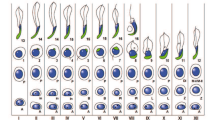Abstract
Suspensions of testicular germ cells from six species of mammals were prepared and stained for the DNA content with a fluorochrome (ethidium bromide) adopting a common technique and subjected to DNA flow cytometry. While uniform staining of the germ cells of the mouse, hamster, rat and monkey could be obtained by treating with 0.5% pepsin for 60 min followed by staining with ethidium bromide for 30 min, that of the guinea pig and rabbit required for optimal staining pepsinization for 90 min and treatment with ethidium bromide for 60 min. The procedure adopted here provided a uniform recovery of over 80% of germ cells with each one of the species tested and the cell population distributed itself according to the DNA content (expressed as C values) into 5 major classes-spermatogonia (2C), cells in S-phase, primary spermatocytes (4C), round spermatids (1C), and elongating/elongated spermatids (HC). Comparison of the DNA distribution pattern of the germ cell populations between species revealed little variation in the relative quantities of cells with 2C (8–11%), S-phase (6–9%), and 4C (6–9%) amount of DNA. Though the spermatid cell populations exhibited variations (1C:31–46%, HCl:7–20% and and HC2:11–25%) they represented the bulk of germ cells (70–80%). The overall conversion of 2C to 1C (1C:2C ratio) and meiotic transformation of 4C cells to 1C (1C:4C ratio) kinetics were relatively constant between the species studied. The present study clearly demonstrates that DNA flow cytometry can be adopted with ease and assurance to quantify germ cell transformation and as such spermatogenesis by analysing a large number of samples with consistency both within and across the species barrier. Any variation from the norms in germ cell proportions observed following treatment, fore.g. hormonal stimulation or deprivation can then be ascribed due to a specific effect of the hormone/drug on single/multiple steps in germ cell transformation
Similar content being viewed by others
References
Aravindan G R and Moudgal N R 1991 FSH deprivation affects spermatogenesis and sperm quality in the adult nonhuman primate; inImmunology — Perspective in reproduction and infection (ed.) S K Gupta (New Delhi: Oxford and IBH) pp 227–232
Aravindan G R, Ravindranath N and Moudgal N R 1991 Use of DNA flow cytometry in assessing gonadotropin regulation of spermatogenesis in monkeys; inPerspectives in primate reproductive biology (eds) N R Moudgal, K Yoshinaga, A J Rao and P R Adiga (New Delhi: Wiley Eastern) pp 189–199
Aravindan G R, Ravindranath N, Gopalakrishnan K and Moudgal N R 1990 DNA flow cytometric analysis of testicular germ cell populations of the bonnet monkey (M. radiata) as a function of sexual maturity;J. Reprod. Fertil. 89 397–406
Clausen O P F, Purvis K and Hansson V 1978a Microflow fluorimetric DNA measurement of isolated testicular cells from the rat;Ann. Biol. Anim. Biochim. Biophys. 18 541–546
Clausen O P F, Purvis K and Hansson V 1978b Quantitation of spermatogenesis by flow cytometric DNA measurments;Int. J. Androl. Suppl. 2 513–521
Clausen O P F, Purvis K and Hansson V 1979 Endocrine correlates of meiosis in the male rat;Arch. Androl. 2 59–66
Clausen O P F, Parvinen M and Krikhus B 1982 Stage-related variations in DNA fluorescence distribution during rat spermatogenic cycle measured by flow cytometry;Cytometry 2 421–425
Isoyama R 1986 DNA flow cytometric evaluation of spermatogenesis of the rebound phenomenon with testosterone in adult male rats;Hinyokika Kiyo 32 981–988
Jeyakumar M, Suresh R and Moudgal N R 1992 Changes in testicular function associated with specific deprivation of luteinising hormone/testosterone in the rabbit;International Conference on Fertility Regulation, IRR, Bombay, India (Abstr.)
Moudgal N R, Ravindranath N, Aravindan G R, Dighe R R and Murthy G S 1988 Anti-FSH antibody as a probe in determining the role of FSH in the maintenance of gonadal function in the primate; inNonsteroidal gonadal factors: physiological roles and possibilities in contraceptive development (eds) G D Hodgen, Z Rosenwaks and J M Spieler (CONRAD Program) pp 249–257
Otto F J, Oldiges H and Jain V K 1984 Flow cytometric measurement of cellular DNA content dispersion induced by mutagenic treatment; inBiological dosimetry (eds) W G Eisert and M L Mendelson (Heidelberg: Springer-Verlag) pp 37–49
Suresh R and Moudgal N R 1992 Nocturnal serum testosterone surge has a regualtory effect on meiotic/post meiotic transformation of testicular germ cells in the bonnet monkey (M. radiata);International Conference on Fertility Regulation, IRR, Bombay, India (Abstr.)
Thorud E, Clausen O P F and Abyholm T 1980 Fine needle aspiration biopsies from human testis evaluated by DNA flow cytometry;Acta Pathol. Microbiol. Scand. (Suppl.) Series A-Flowcytometry 4 175–177
Toppari J, Bishop P C, Parker J W and diZerega G S 1988 DNA flow cytometric analysis of mouse seminiferous epithelium;Cytometry 9 456–462
Toppari J, Mali P and Eerola E 1986 Rat spermatogenesisin vitro traced by quantitative flow cytometry;J. Histochem. Cytochem. 34 1029–1035
Vaishnav Mahima Y 1988Studies on regulation of testicular function by gonadotropins: Regulation of spermatogenesis and Leydig cell function in the rat by follicle stimulating hormone; Ph D thesis, Indian Institute of Science, Bangalore
Vaishnav M Y, Gnanakan A and Moudgal N R 1988 Effect of FSH deprivation on spermatogenesis in the adult rat and monkey: Assessment by DNA flow cytometry;Proc. 8th Int. Congr. Endocrinol, Kyoto, Japan, (Abstr. 16-18-044)
Van Kroonenburgh M J, Van Gasterin H J, Beck J L and Herman C J 1986 A computer model of spermatogeneis in the rat: correlation with flow cytometric data based on autoradiographic cell-cycle properties;Cell Tissue Kinet. 19 171–177
Weinbauer G F, Behre H M, Fingscheidt U and Neischlag E 1991 Human follicle stimualting hormone exerts a stimulatory effect on spermatogenesis, testicular size, and serum inhibin levels in the gonadotropin-releasing hormone antagonist-treated non human primate;Endocrinology 129 981–988
Author information
Authors and Affiliations
Rights and permissions
About this article
Cite this article
Suresh, R., Aravindan, G.R. & Moudgal, N.R. Quantitation of spermatogenesis by DNA flow cytometry: Comparative study among six species of mammals. J Biosci 17, 413–419 (1992). https://doi.org/10.1007/BF02720096
Received:
Revised:
Issue Date:
DOI: https://doi.org/10.1007/BF02720096




